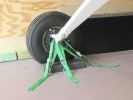
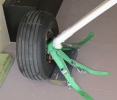
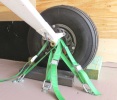
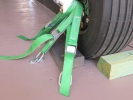
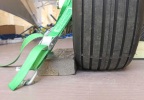
| Aerotrek trailer-tips |
When trailering our Aerotrek aircraft, either in an enclosed trailer or on an open trailer, we normally install some center "guide rails"
(using 2x3 wood boards) so the tail stays in the center of the trailer when loading and unloading, and we install a lot of tie-down rings.
We also put some "leading edge protectors" on the leading edges of the wings as can be seen in some of the photos below. After rolling
the plane in place in or on the trailer, it is essential to properly tie-down the aircraft. Here are some tips with some photos showing
how we do it.
1. Remove the wheel pants and use tie-down straps as shown. We install for each main wheel three tie-down rings with 1/4" bolts and
nylock nut on the underside of the trailer floor -- we don't just use screws into the wood because they are not as strong and will
loosen over time. When using the straps, be very careful to route them such that they do not put any pressure on the brake line. We
use three straps on each wheel/axle area as show, to pull forward, rearward, inward and downward. You can also see that we (permanently)
screw a 2x4 block onto the floor so that the tires cannot scoot inward (as they will otherwise try to do as you go over bumps).





2. For our tricycle-gear aircraft, we always use the optional "trigear tailwheel assembly" as you can see in the photos. This allows the
aircraft to roll around easily, and provides a very strong place to attach tie-down straps as shown in the photos below. What we must NOT
do is put any significant pressure/strain on the Aeropro removable tie-down ring, because it is made of relatively soft steel and will
very easily bend (as intended, so it will bend before instead bending any fuselage frame tubing). When tying-down the tail, the optional
tailwheel tire should be facing towards the front of the plane as shown in the photos below. We tie-down the tail using a good number of
straps as shown -- perhaps over-doing it a bit, but we really, really don't want the tail of the plane shifting from side-to-side or bouncing
up off the floor, especially when hauling our planes in enclosed trailers (where the #1 priority is to keep the plane from hitting the
inside walls of the trailer).
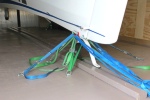
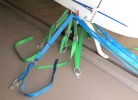
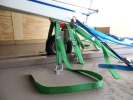
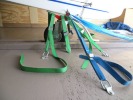
VERY IMPORTANT NOTE: When pulling the aircraft into the trailer, be CERTAIN that one prop blade is straight down, so that the two other
prop blades are at a minimum height. Otherwise, if one prop blade is sticking "up" at all, it may hit the top of the ramp door opening and
the prop blade be damged.
When tying-down a taildragger, we support the tail with some blocks or a bracket of some sort. We must NOT just strap the tail down
and put pressure on the taildragger's tailwheel, because this bends and puts an intolerable amount of strain on the aircraft's fiberglass
tail strut. Instead, the aircraft tailwheel must be held a tiny bit off the trailer floor (i.e., zero pressure/weight being carried by
the aircraft tailwheel). We will add some photos showing this as soon as possible.
3. We like to put some styrofoam blocks on the inside trailer walls to reduce how far the aircraft might sway, and so that if the aircraft
does sway a bit it just taps a foam block and does not cause wing damage. We put these blocks on the forward and rearward leading edges
of the wings, as shown in the photos below. We attach these styrofoam blocks with self-adhesive velcro (with the velcro on the plywood
trailer walls also being stapled down securely, because otherwise the self-adhesive velcro does not tend to remain in place).
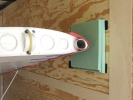
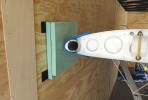
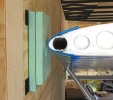
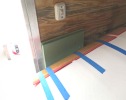
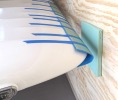
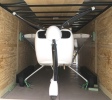

4. As we fold the wings, we place some folded towels over the flaperons so that they will not flop around and rub on the vertical
stabilizer and rudder and cause damage, as shown in the photos below.
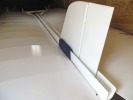
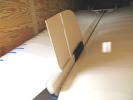
Some additional notes:
(1) Towing on an open trailer is a whole other matter because the aircraft and especially the wings will be out in the
wind and it is very easy to cause damage -- this is a whole separate subject and we will discuss this with aircraft owners if/when
they plan to haul their aircraft on an open trailer.
(2) If you have several helpers, the plane can be pushed in and out of the trailer manually, but if doing this solo then
you really must have an electric winch. It still is not easy (until you get the knack) to pull the plane in the trailer without hitting
the wings on the sides of the trailer door or the inside walls -- so great care must be taken. Also, there are tricks to how you attach
a rope or strap to the rear of the plane so that you can pull it into the trailer without causing damage to the aircraft, and we will try
to provide some more information and details about this as soon as we have time. Please understand that it is best to have the aircraft
loading/unloading and tying-down procedures shown in person rather than try to do this only after looking at photos or reading some text.
(3) Wing-folding is described in some detail in a .pdf file on our Aerotrek-tips web page, but it really needs to be
explained and taught in person so the aircraft owner will know how to do it just right and not risk causing damage to the aircraft.
However, one quick comment... The wings DO need to be securely held back in the folded position, and using the (Aeropro provided) little
brackets with nylock nuts so that the wing fold-back brackets won't come loose during transport.
(4) We greatly prefer to transport our planes with our wing tanks empty or as close to empty as possible. This is to reduce
weight in the wings and just make the aircraft a little lighter for rolling up into the trailer. At most, only fold the wings with the
fuel level at one-half or lower. Otherwise, there is a serious chance that fuel will seep out of the caps or squirt out of the fuel cap
vents while all that bouncing and sloshing-around is going on, and spilled fuel will stain the wings and other paint, and if it gets on
the polycarbonate doors or skylights or other surfaces it causes immediate and permanent damage.
(5) The elevator needs to be secured in basically a "neutral" position -- so that the elevator and especially the elevator
trim tab horn will not hit and damage the bottom of the folded left wing. This usually needs done with a strap in the cockpit and using
the seat/shoulder belts.
if our aircraft owners have questions or suggestions, please contact us!
| for more information, please contact . . . |
|
| home photos videos taildragger wing-folding trailers advantages pricing & options |